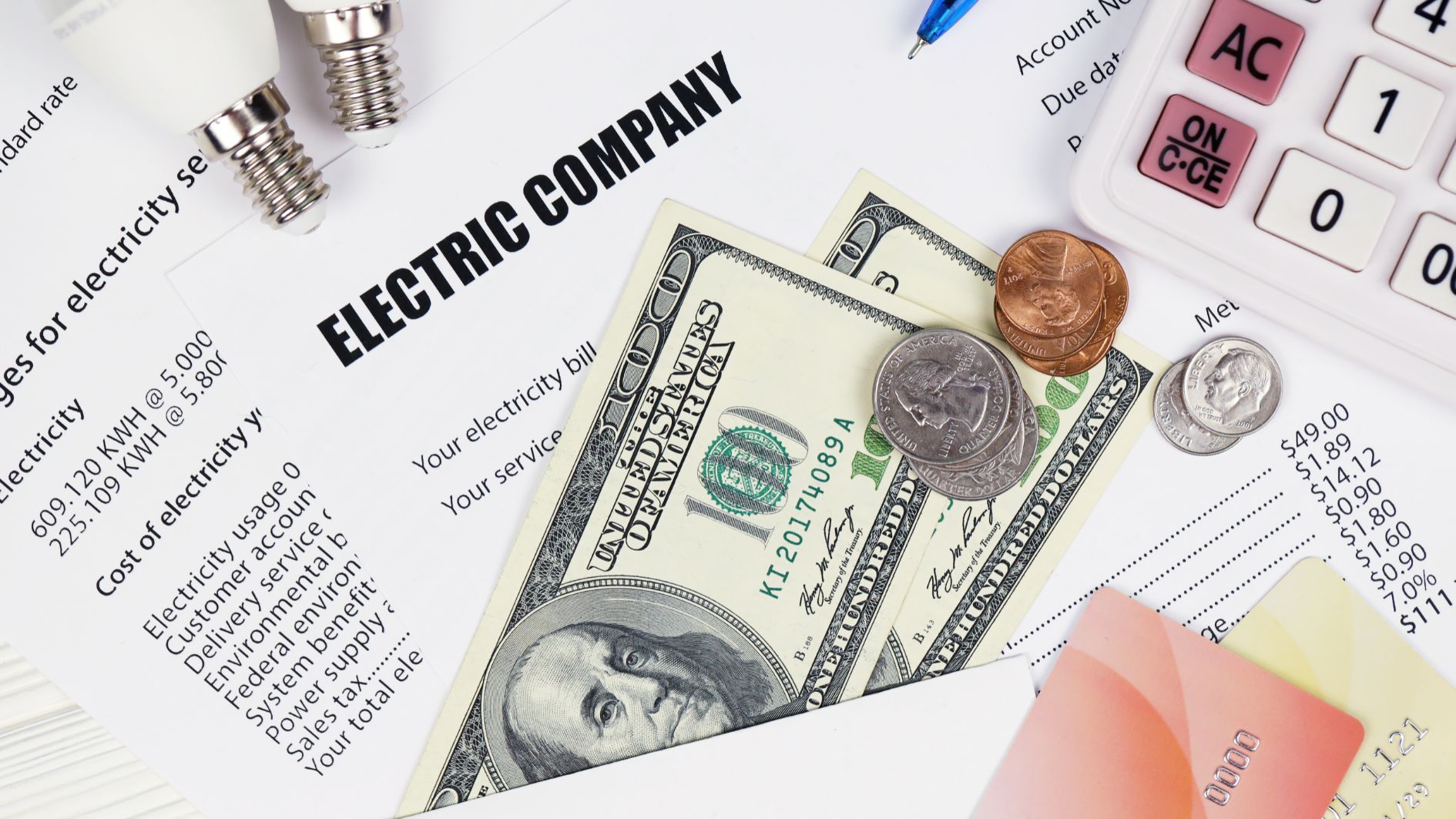Image source: Canva.com
You’ll still receive a bill with solar, but you might not owe anything on it. One common misconception is that installing solar panels eliminates your electricity bill from the utility company. This isn’t true for most cases: most solar panel systems in the U.S. are grid-tied, allowing customers to draw electricity from the grid when their solar panels aren’t producing enough electricity. So, if you install a grid-tied solar panel system, you will continue to receive a monthly electric bill—but how much will that bill be? Here, we’ll review the primary factors that determine how much you’ll need to pay your utility company after installing a solar panel system, including solar electricity production, net metering policies, and fixed utility charges.
What Determines Your Electricity Costs After Going Solar?
Property owners with grid-tied solar panel systems still receive electricity bills from their utility company, but charges on these electric bills vary widely depending on several factors.
Solar Electricity Production
One of the biggest drivers of your monthly bill amount after going solar is how much electricity your solar panel system generates and whether that generation meets your consumption. If you’re using more electricity than your solar panel system generates, your utility company charges you for the extra electricity you draw from the grid. Conversely, if your solar panels produce more electricity than you use in a given month, you may see a credit on your electricity bill, depending on your utility company’s net metering policy.
Net Metering Policy
Net metering is a solar incentive that compensates you for excess solar electricity generation. With net metering, if your solar panels produce more electricity than you’re using, that electricity is sent to the grid in exchange for a credit. You can “bank” these credits and use them when your solar panel system isn’t producing enough (or any) electricity.
Net metering policies vary by state and utility company. Importantly, not every state requires utilities to provide net metering to their solar customers. For instance, states like Alabama, Tennessee, and South Dakota do not have net metering mandates. Therefore, utility companies don’t need to compensate their customers for solar electricity sent to the grid. Most states currently have active net metering incentives, requiring investor-owned utility companies (IOUs) to offer credit to customers sending excess electricity to the grid.
However, it’s more complex than just whether net metering is available in your area, as states offering net metering can have varying compensation structures. Some states and utilities offer customers full credits, while others credit solar customers at a reduced rate. In some areas, the credits you receive depend on the time of day you send solar electricity to the grid (like California‘s net metering 2.0).
Even if you generate enough solar electricity to meet 100% of your needs, you can still owe money to your utility company if you’re receiving net metering credits lower than the rates you’re paying when drawing electricity from the grid. Before signing any solar contract, it’s important to know whether net metering is available and the credit you’ll receive, as this will impact your future electricity bills and overall solar savings.
If you live in an area without a great solar buyback program, don’t give up just yet: With a solar battery, you can store your excess solar electricity to use in the future instead of sending it to the grid. Adding a battery to your solar panel system will increase your upfront cost, but it will save you money down the line. You’ll avoid receiving low compensation from your utility company and should be able to maintain low electric bills.
Fixed Utility Charges
In addition to varying net metering compensation structures, utility companies nationwide impose different fixed charges for their electricity customers, such as delivery or customer service fees. These charges remain the same regardless of how much electricity you consume from the grid and may or may not be covered by any net metering credits you bank from excess generation.
Before going solar, it’s a good idea to ask your utility company which charges you’ll still be responsible for paying after installation. Many solar companies can also provide example bills from past solar customers so that you can see your utility company’s net metering incentive in action.
Is Solar Worth It If You Can’t Offset Your Entire Electric Bill?
Ideally, you’ll be able to eliminate your electric bill charges after going solar. You may even see some negative bills if you can carry over net metering credits month-to-month. But this might not be possible if you don’t have a great net metering policy or if you can’t install a large enough solar panel system.
Even if you can’t eliminate your entire electricity bill with solar panels, you can still drastically lower your electric bills. This can add up to thousands of dollars in savings over time—especially if your cost of solar is low or your electricity rates are high.
When you purchase a solar panel system, you lock in your electricity rate for decades (solar panels typically last at least 25 years). Even if solar only covers part of your overall usage, it helps keep your bills lower and partially protects you from rising electricity rates in the future.
Electricity costs vary significantly from state to state: you’ll pay a lot for electricity in the Northeast and California, while it’s much cheaper in the Pacific Northwest and the South.
How to Estimate Your Potential Savings from Solar
- Calculate the Total Cost: Determine the overall cost of the solar system and installation required to meet your energy needs.
- Apply Incentives: Subtract the Federal Tax Credit and any relevant state incentives from the total cost.
- Assess Your Power Bill: Find out your household’s annual electricity expenses.
- Estimate Savings: Estimate how much of your electricity bill will be offset by your solar system, considering its efficiency and the amount of sunlight it receives.
- Determine Break-Even Point: Divide the adjusted cost of the solar system by the annual savings to calculate how many years it will take to break even with the savings on your electricity bills.
How to Maximize Your Solar Energy Savings
To maximize your solar energy savings, start by thoroughly assessing your property before installing solar panels. Evaluate factors such as sun exposure, roof orientation, and potential shading from trees or nearby structures. Properly positioning the panels can significantly boost their efficiency. Additionally, selecting high-quality panels and an efficient inverter is crucial for optimizing energy production and reducing long-term costs.
Research available federal, state, and local incentives for solar installations, including tax credits, rebates, and grants, which can help offset initial expenses and enhance savings. Also, check if your utility company offers net metering, which allows you to sell excess electricity back to the grid and earn credits on your bill. Utilizing these programs and incentives will further maximize your solar energy savings.





